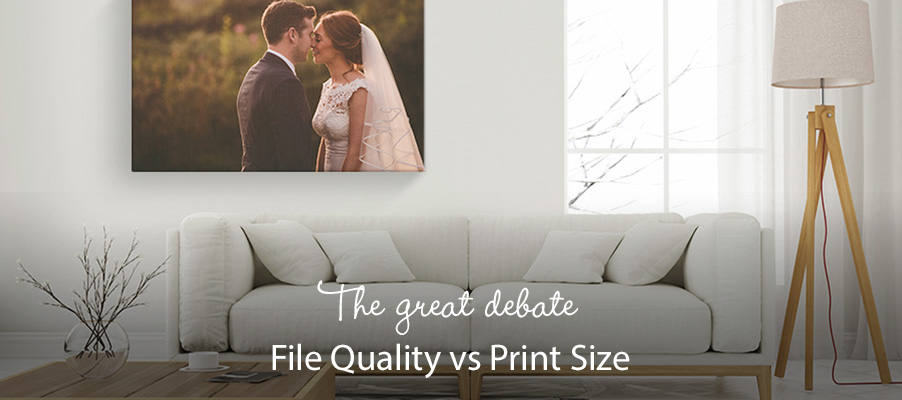So you’re looking at your latest masterpiece and thinking how incredible it would look blown up on a large Alumni or Acrylic Gallery hanging above the mantelpiece. You might be wondering ‘just how large can I go, exactly?’.
The pixel resolution of image files and how it translates to final print quality is a long-debated topic in the photographic community, and unfortunately, the answer inevitably boils down to a slightly facetious-sounding ‘it depends’.
In the printing industry, 300 dpi (dots per inch) in print output terms, or 300 ppi (pixels per inch) in equivalent digital file resolution terms, is considered the gold standard for ensuring a very high-quality print output. As such, the majority of professional and commercial printers are configured to output natively at 300 dpi.
But is an image file with at least 300 ppi always required? We explain why it’s not always necessary to limit your print size so drastically.

How do I calculate the final DPI of a printed image?
Firstly, image files themselves don’t actually have a dpi density on their own. Instead, the dpi count is determined only once you establish the size the file will be printed at.
To calculate the dpi of the file to be printed, divide the horizontal pixel count of your image by the horizontal length of the printed product in inches. For example, an image that is 3,000 pixels long intended to be printed at 10” on the long edge will have a dpi density of 300. An image that is 1,500 pixels long to be printed at the same size will have a dpi density of 150.
What are the challenges of printing large?
When an image is printed large any noise or flaws in the image will become more prominent as these noise areas are also proportionately scaled. This is why it is essential to check every inch of your images and address any imperfections in your image editing software of choice, especially before printing large.
If an image file is printed at a size that would result in a native dpi that differs from the printer’s native output, interpolation – the process of intelligently increasing or decreasing the number of pixels in an image to bridge the resolution gap – is used. However, although interpolation is effective at upscaling an image’s resolution to a point, it can’t work miracles. When this process is pushed too far artefacts such as aliasing, blurring and edge halos can show. Using interpolation to decrease an image file’s resolution to match print output, on the other hand, is not an issue and will not cause any undesirable effects.
So how large can I print?
Ultimately, what constitutes acceptable quality is subjective and there are several factors that will determine the perceived quality of a printed image:
Viewing distance and location
The larger the physical printed product, the more demanding it is on the quality of the image file. However, keep in mind that large prints are intended to be viewed from a distance, allowing the viewer to take in the entire image within their current field-of-view. When viewed from a distance, small defects in an image, such as grain, are less noticeable.
We found that when viewing a 30×20” Acrylic Gallery, viewers naturally stood around one metre away from the product, with no prompting, to take in the full image without having to move to scan their head from side-to-side or rely on out-of-focus peripheral vision. This distance helpfully makes any minor picture noise indistinguishable.
In addition, when considering where to hang the printed product in their home, people will often prefer to have it hanging above furniture such as a sofa, table, desk, mantelpiece or bed, meaning viewers are even less likely to get too close to the print to see any artefacts.

Product type
The print surface of some products is naturally more forgiving of a lower DPI. A product with a less-smooth texture, such as the Canvas Print Wrap, will help to better disguise a shortfall in resolution; while products with incredible clarity, such as the Acrylic Gallery, will show any artefacts in equal clarity.

Personal preference
As artists, photographers will always take pride in their work and want their images to be displayed at their very best. Therefore, it’s up to you to determine what is acceptable by your own personal standards. However, if we take a step back and put ourselves in the shoes of clients and viewers, they are usually more concerned with the emotions the image stirs and less worried about scrutinising every pixel detail than we might be, and it’s important to keep this in mind.
In conclusion
As detailed above, everyone has different perceptions of what is acceptably high quality. While 300dpi with no interpolation/scaling is considered optimal, many customers are completely satisfied printing from files at 200dpi and even as low as 150dpi. We wouldn’t recommend going below 150dpi in most cases, as a rough guideline, however.
For more information on how to save your images when preparing for print output, see our file settings guide and colour calibration guide.

